Budget tripod shootout, Part 3

In Part 1 of this shootout, I previewed the three tripods I’m comparing and discussed some things I’ll be looking at in all three. Part 1 also covered the Velbon CX-300 — a typical “big box” store tripod that’s better than nothing, but just barely. Part 2 of the shootout looked at Dolica’s AX620B100, which turned out to be a big improvement in functionality for a very small incremental spend. In part 3, we’ll look at the Induro A113 / SA01 — a we’d expect to blow the other two away.
As a reminder, if you’re just getting started looking at tripods, Tripod Shopping 101 might also be helpful for you.
Induro A113 / SA01
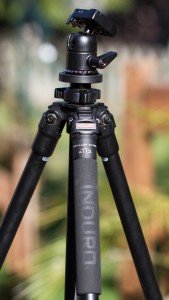
I purchased this Induro kit used for just over $50, which absolutely keeps this tripod in the “budget” category and also demonstrates a great technique for building your personal kit on a budget. Even if you’re nervous about buying a camera body or lens used, there’s comparatively little risk in buying a used tripod.
Unlike the previous two tripods we looked at, this Induro is the first real “name brand” tripod, and it’s the first kit that you might reasonably expect to be able to buy legs and a ballhead separately. Indeed, although you can’t buy exactly these bits anymore, the Induro AT-113 legs and BHS1 Ballhead
are clearly very, very close relatives of these units. Despite these units being available separately, I suspect that most tripods in this range are still purchased in kits (ex: Induro AKB1 Tripod with Ballhead
).
Construction and Specifications
The Induro A113 is a noticeable step up in weight and (perceived) quality relative to the earlier tripods we looked at. The legs, in particular, seem to be of a heavier gauge than the Dolica and Velbon legs, weighing 3.8 pounds for the legs alone. These are three-section legs, so the folded length of the legs is over 22″ — not especially tidy. Fully extended, the legs reach around 49″ without the benefit of the center column, or 58″ with the center column extended. Remember that for maximum stability, you always prefer to keep that center column retracted.
The SA01 ballhead on this combo adds 3.3″ to the height of the tripod and 9.3oz to its weight. As you’ll find with mid-to-high-end ballheads, this is rated for a load capacity — 8.8lbs, in this case. As you might expect, there’s no reason not to trust this rating, but you should be fairly conservative when sizing tripods and heads. If you’re really handing 8+ lbs on your tripod, you might find you’re happier jumping up a rung in the product line.
Features
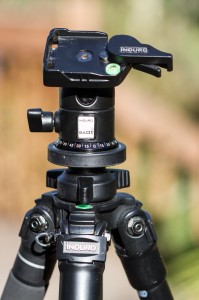
We’d expect to find all the features we saw in the “cheaper” Dolica, and more in this higher-end unit. That’s largely the case here; the Induro A113 / SA01 is a solid kit with a solid list of features for a mid-pack tripod kit:
- All three legs can vary their angles and lengths independently of one another using a small “chock” that locks the leg angle in place. In practice, this works quite smoothly.
- The three-pronged locking ring just above the spider lock a center column that can be reversed to hang down in the middle of the three legs. This is an interesting feature we’ll look more closely at later.
- The three-section aluminum legs feature rather standard rubber feet, but this tripod also comes with a set of spiked feet that can replace the rubber ones. Again, we’ll look at this feature more closely in a bit.
- The SA01 ball head features a single adjustment knob that locks the head in place for panning, tilting, and rotation. Degree markings can be used to show rotation of the head for panoramas.
- A quick-release plate and adapter are included.
- The tripod has a tiny little bubble level and a compass on the spider, and another bubble level on the quick-release adapter.
- There’s a small loop on the spider that can be used to clip the tripod to a strap, backpack, etc.
- The center column has a spring-loaded hook on the bottom that’s suitable for hanging a weight.
- My kit came with a padded carrying case and strap. Included in the case is a small tool kit with wrench, allen keys, and the aforementioned spiked feet.
All-in-all, then, this kit seems to have everything we’d want to see in a tripod — let’s see how well it all works.
Operation
 The three-section legs of the Induro A113 are quite strong, and the snug-fitting sections are joined with twist locks. To extend the legs, the locks twist counter-clockwise to open, and then tighten again to lock each leg in place. With practice, it’s possible to loosen both locks on a leg with one motion, which makes extending the legs a very quick motion.
The three-section legs of the Induro A113 are quite strong, and the snug-fitting sections are joined with twist locks. To extend the legs, the locks twist counter-clockwise to open, and then tighten again to lock each leg in place. With practice, it’s possible to loosen both locks on a leg with one motion, which makes extending the legs a very quick motion.
As expected, each leg can be adjusted independently for length, as well as for angle. The angle adjustment is particularly nice — there’s a little block that pulls out to allow the legs to move, and when it’s slid back into position, it works as a chock to lock the leg in place in one of three angles (24,55 & 80°). Although this might not seem to be a very elegant design, this is one of those places where a simple design is perfect. The hardware connecting the legs to the spider — seen in the photo at the right — is adjustable using a wrench supplied in the included toolkit. Again, this is a a simple design that works quite well.
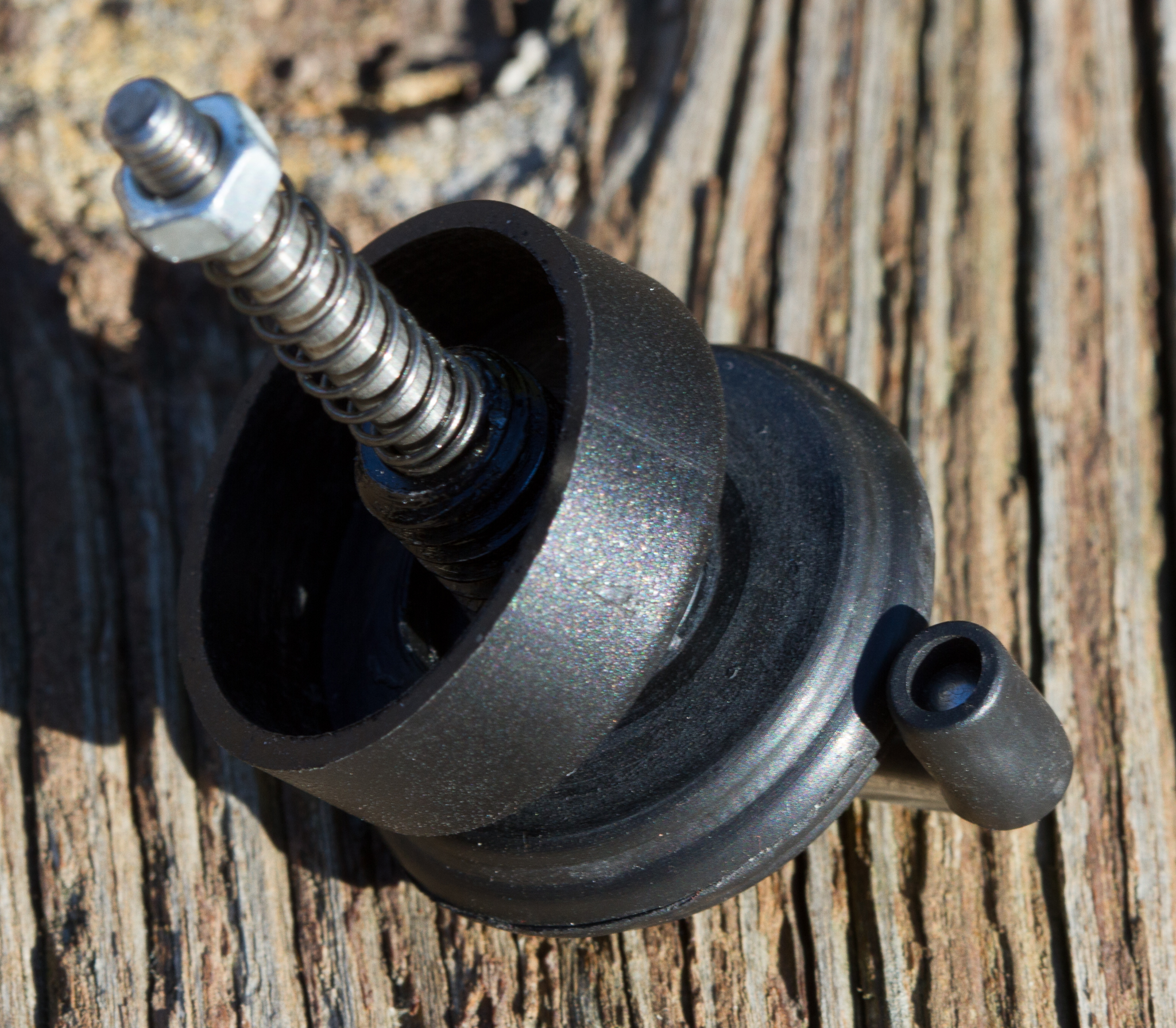 The center column of the A113 is locked in place with a winged collar, which works smoothly. In addition to elevating, the center column also reverses to let it hang upside down. To reverse the column, there is a cap on the bottom of the column that unscrews to allow the column to lift out of the spider. You can then re-insert the column upside down and tighten the collar to lock the column in place. Replacing the cap will keep the column from slipping out. Unlike some other operating mechanisms on this tripod, the reversing center column is fairly awkward. It works, but it’s a bit of a pain.
The center column of the A113 is locked in place with a winged collar, which works smoothly. In addition to elevating, the center column also reverses to let it hang upside down. To reverse the column, there is a cap on the bottom of the column that unscrews to allow the column to lift out of the spider. You can then re-insert the column upside down and tighten the collar to lock the column in place. Replacing the cap will keep the column from slipping out. Unlike some other operating mechanisms on this tripod, the reversing center column is fairly awkward. It works, but it’s a bit of a pain.
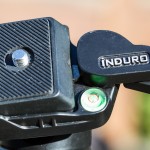 Moving on to the ballhead, we see a design fairly similar to the Dolica, with a single locking lever, though the mechanism is noticeably smoother than the head on the Dolica. The base of the head is also marked in degrees to help when taking panoramic photos, though the single-lever design of this head makes this fairly impractical. The SA01 head is fitted with a quick-release receiver and plate — again, very similar to the Dolica, though not so similar that the plates are compatible.
Moving on to the ballhead, we see a design fairly similar to the Dolica, with a single locking lever, though the mechanism is noticeably smoother than the head on the Dolica. The base of the head is also marked in degrees to help when taking panoramic photos, though the single-lever design of this head makes this fairly impractical. The SA01 head is fitted with a quick-release receiver and plate — again, very similar to the Dolica, though not so similar that the plates are compatible.
The bubble levels on the spider and the quick-release plate are small but reasonably functional. The purpose of the bubble on the plate is pretty straightforward, but if you haven’t seen a bubble on tripod legs before, it’s purpose might be less clear. By leveling the legs themselves and then swiveling the head from side to side, you’ll be able to shoot a series of photos that line up with one another horizontally — a panorama. Of course, in this case, the single-lever head makes that difficult, but you get the idea.
In the Field Performance
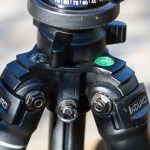 As you might have guessed, this is a tripod that comes close to exceeding the Dolica on several fronts, but it wound up being pretty frustrating for me to use. Starting with the good points, though, this is a really solid tripod that does an admirable job of steadying the camera. Both the legs and the head are easy to use for “normal” shots, and I never felt that I came anywhere near exploring the limits of its weight-bearing capabilities with a Canon 7D, 70-300 zoom, and strobe. I’d trust it with close to twice that amount of weight without any concern whatsoever.
As you might have guessed, this is a tripod that comes close to exceeding the Dolica on several fronts, but it wound up being pretty frustrating for me to use. Starting with the good points, though, this is a really solid tripod that does an admirable job of steadying the camera. Both the legs and the head are easy to use for “normal” shots, and I never felt that I came anywhere near exploring the limits of its weight-bearing capabilities with a Canon 7D, 70-300 zoom, and strobe. I’d trust it with close to twice that amount of weight without any concern whatsoever.
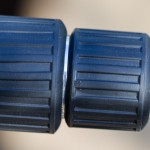 Next, let’s talk about the operation of the legs. If twist-locks are your cup of tea, you’ll probably like these. While using this Induro, I discovered that I’m not a fan of twist locks, and I’m certainly not a big fan of these. I’ll give credit where credit is due — they’re really quick to extend. As soon as I tried to retract them again, though, I started running into problems. I soon discovered, for instance, that the order you tighten the locks in is important. Do it wrong, and the locks just won’t grip — even if they’re tight. I spend a lot of time contorting my tripods into goofy positions for landscapes, macros, and so on, and I also discovered that when I was on my hands & knees with legs splayed out all over, I twisted the locks the wrong way on more than one occasion. This isn’t an indictment of the Induro, of course, as much as an observation that there’s just no such thing as a direction for flip locks — one more reason I prefer them.
Next, let’s talk about the operation of the legs. If twist-locks are your cup of tea, you’ll probably like these. While using this Induro, I discovered that I’m not a fan of twist locks, and I’m certainly not a big fan of these. I’ll give credit where credit is due — they’re really quick to extend. As soon as I tried to retract them again, though, I started running into problems. I soon discovered, for instance, that the order you tighten the locks in is important. Do it wrong, and the locks just won’t grip — even if they’re tight. I spend a lot of time contorting my tripods into goofy positions for landscapes, macros, and so on, and I also discovered that when I was on my hands & knees with legs splayed out all over, I twisted the locks the wrong way on more than one occasion. This isn’t an indictment of the Induro, of course, as much as an observation that there’s just no such thing as a direction for flip locks — one more reason I prefer them.
Continuing with the legs. one of the legs is covered in foam, which helps cushion the leg and insulate it a bit in cold weather. Why just one leg? Beats me. The “cheap” Dolica managed to find the budget to put foam on all three legs! I never did get the knack of grabbing only the foam-covered leg on the Induro, and I sure wasn’t able to arrange it so only the foam-covered leg bounced against me when I was hiking. Pretty silly.
 I felt the same about the feet / tips. Even though it was great of Induro to include spiked feet with the tripod, and I love the little carrying case / tool bag they came in, I remain spoiled by the far superior all-in-one design of the Dolica feet. Not only are they tool-less, I can spin the rubber pads up or down in a fraction of the time it took me to unpack the Induro case, get the spikes out, unscrew the rubber feet, thread the spikes, tighten the spikes, stow the rubber feet, and put the toolkit away. The best part? No lost spikes or feet!
I felt the same about the feet / tips. Even though it was great of Induro to include spiked feet with the tripod, and I love the little carrying case / tool bag they came in, I remain spoiled by the far superior all-in-one design of the Dolica feet. Not only are they tool-less, I can spin the rubber pads up or down in a fraction of the time it took me to unpack the Induro case, get the spikes out, unscrew the rubber feet, thread the spikes, tighten the spikes, stow the rubber feet, and put the toolkit away. The best part? No lost spikes or feet!
Along with the tool kit, my Induro kit came in a very nice padded carrying case. As I mentioned, I bought this tripod used, though, and the zipper is basically shot on the case. The shoulder strap is detachable, though, and it works just fine to carry the tripod when affixed to the eyelet on the spider.
Moving on to the ballhead, things get a little better. This single-lever head is quick and easy to adjust, and it holds tight. Alternatives to the single-lever design, by the way, include designs that use two or three knobs to control the various aspects of operation. One of the very few drawbacks to using only one lever to tighten the ball is that it really impacts the use of this type of head for panoramas (making the inclusion of the scale around the base of the head rather confusing. The problem here is that you must loosen the knob to rotate the head, but doing so will also let the head move in all other planes, which you definitely don’t want when shooting a panorama. Ironically, one of the tricks I used to use with the Dolica isn’t available here. With the Dolica, I could loosen the collar for the center column and simply spin the whole column in the spider, but this Induro has a keyed center column that stops it from turning. The only saving grace here is that if your kit is relatively well-balanced on the head, you might have a chance of moving the head laterally without changing the attitude of the camera, but this would be a pretty delicate operation, and would definitely be a source of frustration if you needed to do this on a regular basis.
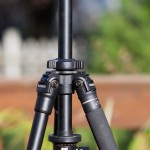 One of the features I was really excited about with this tripod was the reversible center column. As seen in the Dolica review, I love to shoot from a low point of view for landscapes, and for macros, of course, it’s essential to be able to get low. The reversible center column of the Induro permits positioning of the camera that you simply cannot duplicate with the Dolica. As I’ve mentioned before, so many tripod comparisons are matters of degree — one is a little lighter, one is a little easier, and so on. Not in this case — this should be a killer differentiation for the Induro, and in practice, it does work — but just barely.
One of the features I was really excited about with this tripod was the reversible center column. As seen in the Dolica review, I love to shoot from a low point of view for landscapes, and for macros, of course, it’s essential to be able to get low. The reversible center column of the Induro permits positioning of the camera that you simply cannot duplicate with the Dolica. As I’ve mentioned before, so many tripod comparisons are matters of degree — one is a little lighter, one is a little easier, and so on. Not in this case — this should be a killer differentiation for the Induro, and in practice, it does work — but just barely.
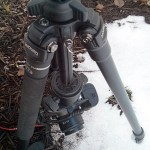 Problem one is the mechanism of flipping the column, which requires unscrewing the bottom of the column and then re-attaching once the column is flipped. This seems more awkward than it needs to be, but it’s not a fatal flaw. Problem two, though, is pervasive and really frustrating, if abundantly obvious: your camera will be mounted upside-down. This means, of course, that all the controls are out of sight and buried in the dirt / snow / mud / leaves / what have you. It also means that your shots are going to wind up flipped when you import them. This second problem is fairly easy to fix, of course, and it might even be handled automatically if your camera has an orientation sensor, but still — there it is. In day-to-day use, this sort of thing you can live with if you don’t have an alternative, but I can assure you that it drove me a little batty in pretty short order.
Problem one is the mechanism of flipping the column, which requires unscrewing the bottom of the column and then re-attaching once the column is flipped. This seems more awkward than it needs to be, but it’s not a fatal flaw. Problem two, though, is pervasive and really frustrating, if abundantly obvious: your camera will be mounted upside-down. This means, of course, that all the controls are out of sight and buried in the dirt / snow / mud / leaves / what have you. It also means that your shots are going to wind up flipped when you import them. This second problem is fairly easy to fix, of course, and it might even be handled automatically if your camera has an orientation sensor, but still — there it is. In day-to-day use, this sort of thing you can live with if you don’t have an alternative, but I can assure you that it drove me a little batty in pretty short order.
Conclusion
This was a tripod I really wanted to love. After the two no-name tripods I owned before this one, this Induro is a “real” name-brand, quality piece of kit. The quality shows in its build and stability, and I think if I used my tripod mainly for shooting in the strike zone, and I didn’t want to shoot a lot of panoramas, and I didn’t want to hike with it, this would be an outstanding buy – especially at the price I paid for mine used.
The problem is that I do bring my tripod hiking, and I do shoot at all sorts of weird angles and positions, and I do shoot panoramas, so as much as I wanted to like this kit, I just can’t see it as a clear winner vs. the less-pedigreed Dolica, and I couldn’t be satisfied with this tripod as my daily companion.
A final teaser for the next tripod review: it won’t be part of the budget tripod shootout, because I took a big jump up in price to find the legs I’m using now. Until then, get out there and shoot!
Comments are closed.

4 Comments